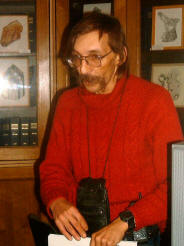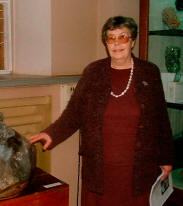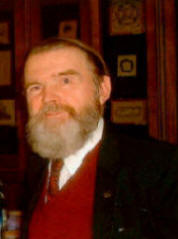 |
|
|
Vladimir A. Malítsev
Geologist, mathematician, speleologist,
photoartist.
There is an old Chinese saying: One picture is
equal to ten thousand words. Well, how did they
know that much about informatics in those
dust-covered times?
Contrasting science
against art is a threadbare. Why? On the
contrary, if God (or Nature) created Man as a
creator, one cannot expect that he will turn to
his Creative Act at once, skipping preparations,
training, and learning. To approach the Creative
Act for human beings today just two feasible
ways exist, with the results comparable to
creation of new worlds. One leads through
scientific studies, which discover new parts or
levels of the existing world. Another way is to
build a world of oneís own through artistic
creation. It is not in vain instincts are
combined with attraction both to Beauty and
Unknown, whatever old Freud stated. For the time
being a thin wall occurs between these ways,
these approaches. This wall gradually thins out
washed away by the accelerating flood of life
and a permanent process of acquiring more and
more precise notions on the nature of things.
This wall is called Artistic Search.
Masters of the Artistic Search were always
highly praised, be it the search in Word or
Visual Arts. Genre photographs done early in the
20th century saved much evidence, which
disappeared from history during the everlasting
re-writing of the latter or omitted by those who
kept the records as insignificant. Leonardoís
paintings developed anatomy as much as efforts
of hundreds of scholars. Books by Vladimir
Arseníev, Oleg Kuvaev, Thor Heyerdahl, Jerald
Durrell, Haroun Tazieff, and many others
attracted to Science versatile brains in much
greater quantities than strains of the pure
science popularizers for centuries. It is always
more important to generate a sparkle and
initiate flames than to feed active campfire.
Graphics (and not exclusively graphics) of
Victor Slyotov was born as illustrations to
scientific papers when we were students. That
was a good time for Soviet science, and the
papers were in demand. Units and dozens read
scientific papers instead of thousands after
perestroika. Probably, this is the reason why
Victor disappeared from my sight for many years.
A scientific research may be presented to a
small audience, but not an Artistic Study. It is
valuable mainly due to awaken associations in
those who are, maybe in part, outside their
narrow cells. This kind of readers of
mineralogical papers is extinct.
Years passed, and once upon a time I got a phone
call. An invitation to a joint exhibition of
Victor and some co-author unknown to me.
Honestly, I felt proud for the science where the
illustrative graphics presented at Victorís
level became an absolute rarity by the end of
the 19th century. But no more than that. I was
not ready to know that a new duet of authors
left a solid ground of Scientific Study for a
narrow and swampy soil of the Artistic One.
Naturally, I went to the exhibition. And got a
bang on my head. Been so impressed that when
asked to comment in public managed to mumble a
couple of phrases. Writing these lines with
pleasure I compensate my failed speech. Maybe it
is better this way: the auditorium is much
wider.
Victor and Vladimir are dealing with a very
complex problem. Ontogeny of minerals, i.e.,
studies of the Ilife cycl & of minor mineral
bodies and modes these interact, deal with
self-organization of inorganic matter.
Scientific disciplines, which representatives
tried to jump over this hurdle with no sweat
(e.g., inequilibrium thermodynamics, synergetic)
got swamped in huge equation systems
indigestible even by modern computers. A totally
different mathematical approach is needed here,
and its development will take time. What is the
worst, these disciplines never worked out a term
base sufficient to manage the information flow
outside conventional narrow limits of available
inadequate mathematical models. The environment,
which is the best capacitor of Knowledge is the
Artistic Study. Naturally, the Art of Word
included. However, let us recall the quotation
that opens these pages and try to compare the
amount of accumulated Knowledge at least with
the number of living Masters of the Word. Well,
visual images. Pictures. Photographs, naturally,
the artistic ones. These may jump into eyes of
some future specialist dealing with totally
different area and give him a hint, and he will
find a Clue. Documentary images will be buried
in narrow specialized archives dug exceptionally
by those whose sight is narrow by nature or due
to position occupied.
The technique the masters took up, i.e.,
painting and not photography, may be disputable.
Yes, painting like mathematics slightly binds an
artist with his notions and models, and this may
lead to errors. However, a complete naturalism
of a photograph is but an illusion. A good
photographer displays an image he sees, not a
reality. In return, painting opens a possibility
to put on view nuances undistinguishable to any
optical devices. As for mistakes and errors,
these are assigned to those whom this visual
message is addressed to, and the addressees will
not be confused, they would note them, and turn
to the faultless works.
All in all, having started this text I
conscientiously did not ask Victor and Vladimir
to demonstrate me the new pieces, which you, the
Spectator see now in front of you. I am
interested to see it for myself, whether I
failed in my extrapolation from the issue I to
the future. I do believe Victor and Vladimir
will not join the rat race of the current period
trying to copy the tactics once successful. I
expect something new, disputable, beautiful, and
interesting.
~~~~~~~~~~~~~~~~~~~~~~~~~~~~~~~~~~~~~~~~~~~~~~~~~~~
~~~~~~~~~~~~~~~~~~~~~~~~~~~~~~~~~~~~~~~~~~~~~
"WONDERFUL DRAWINGS OF MINERALS BY VICTOR
SLYOTOV AND VLADIMIR MAKARENKO"
Yuri M. Dymkov
All-Russian SRI of Chemical Technology,
Moscow.
In eightieth years of the last century I had
friendly contacts with a small group of active
and talented young men, amateurs of minerals,
friends of Victor Arnolídovich Slyotov. I has
"grandiloquently" addressed to one of them:
Be a Person in great and small,
While the fire in
soul burns.
And my advice:
grow as crystal!
Donít split in
spherulite!
Life tectonic faults, "vpuki and vypuki"
(Russian substitutions of terms "synclines" and
"anticlinese"; it is attributed to Vera A.
Varsanofíeva) of long-awaited democracy
dispersed this interesting group. One of them,
philosopher by nature, has got this degree in
the area of Mineralogy and flew away to London,
where he had a job at a petrol station. Another
guy deals with the physics of minerals. The
third guy gifted geologist and mathematician is
unfortunately far from mineralogy now. Life of
Victor Slyotov developed otherwise. After
graduating from the Geological department of the
Lomonosov MSU, as early as "perestroika" began,
he was crippled by bandits for refusal to sign a
self-slander. Bandits were just punished, but
Victor obtained physical inability for all
remained life. But love to stones and habit to
work were stronger than circumstances, and he
began to fulfil his old idea: to draw minerals.
In 2004 V. A. Slyotov was awarded to honorary
title of laureate of the international premium
"Philanthropist" for prominent achievements of
invalids in culture and art (special premium
"For novelty and originality in creation").
Project "Mineral Drawings" obtained its first
recognition! Originality of ideas and quality of
their artistic performance in albums "Mineral
Drawings" have amazed the jury. In 2001-2004
three such albums were published, two later with
subheading "Ontogeny of minerals in drawings".
Drawings are interesting not
only for artists but also for mineralogists,
however, we shall note that all three albums of
drawings by V. Slyotov and V. Makarenko are not
a regular scientific work: they are unsystematic
both in selection of mineralogical objects and
in order of arrangement of drawings. This is
certainly art approach: the object is interested
for creator - both as artist with aesthetic
point of view and mineralogist with scientific
point of view. However one recollects H. Heine:
"Nightingales sing without rules, only when
desire". But scientific part in drawings is more
than essential.
Science and art have
different cognitive potentials, and their unity
in obtaining universal general information about
environment and world of stones is especially
valuable. Artistic image of mineralogical
object, which is created by specialist
understanding a point of fact, has an extra
significance for interpretation of mineral
genesis and fist of all for revelation of the
way of growth, dissolution, and
recrystallization of minerals in druses and
concretions, i.e. the questions insignificantly
known and in essence raised by V. Slyotov.
Detailed images of
morphology, especially the surface of crystals
and spherulites, which are drawn during study of
minerals under binocular (stereomicroscope),
give the "rich food" for genetic mineralogy and
first of all minerals ontogeny, that studies
development of mineral individ and aggregates,
their "life". Mechanism of formations and
development of germs of crystals and spherulites,
their further growth and subsequent
mineralogical events: dissolution,
recrystallization, regeneration, etc. And all
that by features recorded on the minerals.
Victor Slyotov entirely follows to the ideas of
founder of mineral ontogeny, professor D. P.
Grigoríev who encouraged mineralogists to study
and understand stones as true source of main and
different mineralogical information and
aesthetic beauty.
Subtitle "Ontogeny of
minerals in drawings" on the second issue
clearly determines mineralogical tendency, in
which mineralogist and artist Victor Slyotov and
his student and coauthor, artist Vladimir
Makarenko work. Many graphic (white-black)
drawings are made by authors with such accuracy
and detailed elaboration (minuteness) that they
do not demand explanations of specialists who
can estimate novelty and scientific value of
good and in many respects unique factual
material.
Examples of plastic
deformations of antimonite crystals by growing
in them thin-grained aggregate of partly
crystallized quartz grains are wonderful (Fig.
12, 13, N. 1). Many colour drawings (water-colour)
made by V. Slyotov together with V. Makarenko
are very informative and marvellous too. Here it
is enough to mention the picture of simultaneous
recrystallization of two different mineral
individs, celestine and natural sulphur with
features of simultaneous dissolution and growth
(Fig. 24, N. 3). All colour drawings are an
excellent supplement to graphic materials. Many
of them undoubtedly are aniazing for collectors,
amateurs, and connoisseurs of minerals. V.
Slyotovís graphical images of silica concretions
and V. Makarenkoís colour Indian ink drawings of
smoky quartz and amethyst in the first issue are
gorgeous. Gypsum antholites growing by its basis
on porous basement (Fig. 1, N. 2), vivianite in
a shell (Fig. 30, N. 2), covellite sheet on
chalcopyrite crystal (Fig. 24, N. 2),
alexandrite twin (back cover, N. 2) and many
other things are excellently drawn. In acolour"
image of brightly coloured minerals the
complexities in combination of colours appeared.
That in small specimen is excellently combined,
during magnification on paper can look rather
coarse (Fig. 20, N. 3). In that case it would be
possible to adeviate from nature and to use to
less saturated colours for quartzite. Authors
choice of mineral object and technique of image
are rather emotional and are not deprived
elegancy and refinement. But for the
crystallographic purposes, the perspective,
shadows, creating and underlining effect of
specimen dimension, are not shown and taken into
account everywhere. In all that is shown, the
drawing is minute, and hardly perceptible
thickening of lines or strokes becomes enough
for sensation of tridimensionality perception of
crystals and druses. The only remark is
concerned - Fig. 8, N. 1, where one octahedron
looks convex.
Precise scientific drawings
what motive the artist would not be guided by
are extremely labour-consuming. Nevertheless, we
hope the authors will continue their creative
job and the new special art albums on mineral
ontogeny will be issued.
V. Slyotovís attempt of to
use mineral forms for creation of abstract
artistic images (Fig. 11, N. 2), dendritic art
landscapes (Fig. 6, N. 1; Fig. 8 and 9, N. 2),
pictures of turned specimen of limonite (Fig.
10, N. 2) is interesting.
The albums are an excellent
present for collectors and amateurs of stones;
which extends their ideas about mineral world.
For specialists interesting in mineral genesis,
it is in many respects the collection of
scientific articles in pictures, containing a
little known and new information. For teachers
of mineralogy, natural sciences or natural
history the albums give a possibility to arrange
from separate figures different thematic posters
for students, for example, "Minerals of silica"
(crystals and aggregates of quartz, geods and
concretions of chalcedony, agates), using more
than 20 lists; a Skeleton crystals and
dendrites" (18 drawings); Spherulits and fibrous
aggregates" (20 drawings); "Mineral aggregates
of caves" (9 drawings); "Twin inter- growths"
(10 drawings), etc.
An unfortunate imperfection
of the albums is their price that is relatively
high for ordinary scientific employers and
students. Unfortunately, the albums were
published only at the authorsí expenses, and the
price was established in hope though in any
measure to compensate their expenses. It is real
pleasure to say great thank you to the director
of the Fersman Mineralogical Museum RAS, Doctor
of Geological-Mineralogical Sciences, Professor
Margarita I. Novgorodova and collaborators of
this Museum Tatiana M. Pavlova, Alexander A.
Evseev, Dmitriy I. Belakovsky who in their best
way promoted the publications. Realization of
project a Mineral Drawings" hardly would
possible without their unselfish help and
support.
It would be desirable to
trust that further fruitful collaboration of the
authors and the Mineralogical Museum, where was
the presentation of the first album "Drawing
Minerals" took place and the exhibition of works
of V. A. Slyotov and V. S. Makarenko was
organized, will be even more successful, and
they will please experts and amateurs of
minerals with new interesting works. It is also
appropriate to mention that there are 192
specimens of different minerals in Museum
collection presented by Victor. A. Slyotov.
------------------------***-----------------------
(Was
Published in "New Data on Minerals", Issue 40,
2005.,
Moscow, Ocean Pictures)
|
|



